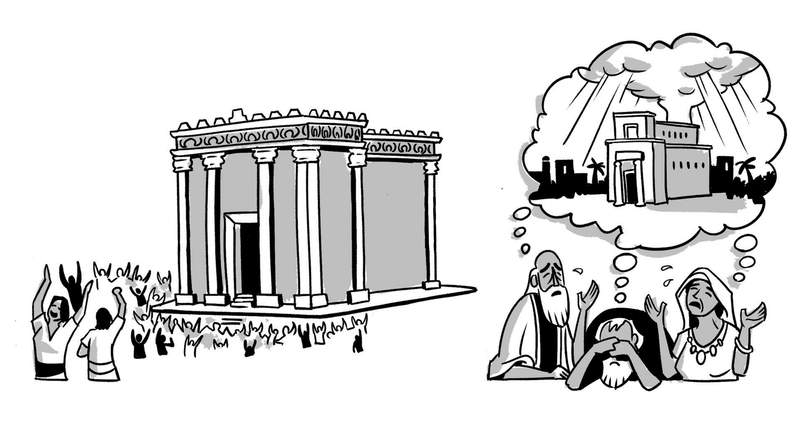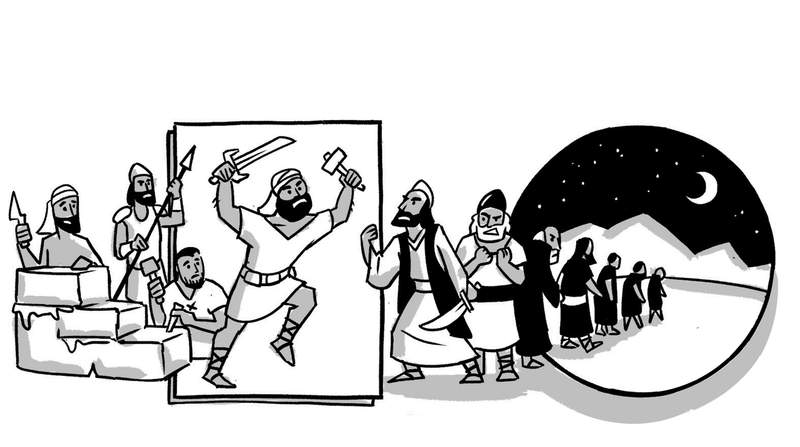The Book of Ezra-Nehemiah
About

In most modern Bibles, Ezra-Nehemiah is two separate books, but that division happened long after it was written. It was originally a unified work written by a single author who lived long after the Babylonians’ invasion of Jerusalem and the exile (2 Kgs. 24-25). Ezra-Nehemiah picks up some fifty years later and tells of the return of some Israelites to Jerusalem and what happened when they rebuilt their lives and the city.
More specifically, the book focuses in on three key leaders who led the rebuilding efforts: Zerubbabel, Ezra, and Nehemiah. Zerubbabel first led a large group back to Jerusalem to rebuild the temple (Ezra 1-6). About 60 years later, Ezra arrived in Jerusalem to teach the Torah and to rebuild the community (Ezra 7-10). He was soon followed by Nehemiah, who led the rebuilding of Jerusalem’s walls (Neh. 1-7).
All three stories are designed to be parallel to one other. Each begins with a king of Persia being prompted by God to send a leader to Jerusalem while offering resources and support. Then, each leader encounters opposition in their efforts, which they overcome, but in a way that leads to a strange anticlimax.
Who Wrote the Book of Ezra-Nehemiah?
Context
Literary Styles
Key Themes
- God’s faithfulness to Israel
- Covenant renewal and the new covenant
- The exile and return from exile
- Reconstruction of Jerusalem and rededication to God
Structure
Ezra 1-6: Zerubbabel Leads First Exiles Back and Rebuilds Temple
The story begins with a decree from Cyrus (Ezra 1:1-4), the king of Persia who is moved by God to allow the exiles to return to Jerusalem and rebuild the temple. The author says that this fulfills a promise made by the prophet Jeremiah (Jer. 25) that the exiles would one day return. Now, this fulfillment should trigger our hopes in many other prophetic promises that Israel’s exile was not the end of their story. The reader should recall the prophetic hopes for a messianic king from the line of David (Isa. 11; Hos. 3), for a rebuilt temple where God’s holy presence will dwell (Ezek. 40-48; Zech. 2), and for God’s Kingdom to come over all the nations and bring his blessing upon everyone (Isa. 2; Zech. 8) just as he promised Abraham (Gen. 12:1-3).
It’s with all these hopes in mind that we read the story of Zerubbabel. His name means “planted in Babylon.” He represents the generation born in Babylonian captivity, and he leads a wave of people back to Jerusalem (Ezra 1-2).
After they settle in Jerusalem, they rebuild the altar for offering sacrifices and later the temple itself. The foundation laying ceremony (Ezra 3) and the temple’s final dedication (Ezra 6) are key moments. The past stories of the tabernacle and temple’s dedication when the fiery cloud of God’s presence descended should come to mind (Lev. 9; 1 Kgs. 8). That’s not what happens in this case, and while some people were happy about the new temple, the elders who had seen the previous temple of Solomon cry out in grief. This building is nothing like their glorious past or the hopes they had for the future.

It’s here that we get the first story of opposition, and it’s an odd one. The descendants of the Israelites who were not taken into exile and had been living around Jerusalem for some time come and offer help with the temple rebuilding (Ezra 4). Zerubbabel refuses and says, “You have no part in our temple!” This understandably generates conflict, which Zerubbabel eventually overcomes, but we should feel disappointed. The prophets had envisioned the tribes of Israel coming together with all nations to participate in the worship of the God of Israel when his Kingdom finally came (Isa. 2; Zech. 8). This turn of events is an anticlimactic opening to say the least.
Ezra 7-10: Ezra Leads More Israelites Back and Decrees Divorce
In the next section (Ezra 7-10), we move decades into the future and are introduced to Ezra, a leader among the exiled Israelites in Babylon. He’s a Torah scholar and teacher and is appointed by Artaxerxes, king of Persia, to lead another wave of people back to Jerusalem. He wants to bring about social and spiritual renewal among the people.
Our hopes are set high, but once again we come to another strange, anticlimactic moment in the story with chapters 9-10. Ezra learns that many of the exiled Israelites had returned and married non-exiles who had been living around Jerusalem, some who were not Israelites and some who probably were. Ezra then appeals to the commands of the Torah that Israel should be holy and separate from the ancient Canaanites (Deut. 23:1-4), and continues by saying that the people living around Jerusalem are like the Canaanites and will corrupt the exiles. He offers a prayer of repentance, which is very heartfelt, but then he rallies all the leaders during a rainstorm. He enacts a divorce decree that will annul these marriages and send all these women and their children away. This decree is only partially carried out, but we’re given a list of some of the men who went through with it.
This story is strange for a number of reasons. God never commanded Ezra to do any of this. It was the leaders of Jerusalem who compelled Ezra to make the decree. While the contemporary prophet Malachi did say that the exiles should care about purity, he went on to say that God was opposed to divorce (Mal. 2:13-16). The mixed results of the decree fit well into this pattern of strange, disappointing endings.
Nehemiah 1-7: Nehemiah Returns to Rebuild Jerusalem’s Walls
This leads us to the section about Nehemiah, who’s an Israelite official serving in the Persian government (Neh. 1-7). When he hears about the ruined state of Jerusalem’s walls, he prays and is given permission from the Persian king Artaxerxes to go and rebuild the walls. The king even gives him an armed escort and extra resources. After arriving and beginning the building project, he too faces opposition from the people who were already living around Jerusalem. We once again face a tension in the story. The contemporary prophet Zechariah said that the new Jerusalem of God’s Kingdom would be a city without walls, surrounded by God’s presence and joined by people from all nations (Zech. 2:3-11). Nehemiah seems to operate with the opposite vision. He informs the people surrounding Jerusalem that they have “no part” in the city (Neh. 2:19-20), which provokes them to hostility. While Nehemiah carries out his vision for the city with integrity and bravely protects the city with armed guards, we are left wondering if this whole conflict could have been handled differently.

Nehemiah 8-13: A Great Festival Followed by Nehemiah’s Failure
The conclusion to the book comes in two movements, the first positive (Neh. 8-12) and the other negative (Neh. 13). Ezra and Nehemiah combine forces to bring about spiritual renewal among the people. They gather the former exiles for a great festival where they read and teach the Torah to all the people for seven days. Next, they celebrate the Feast of Tabernacles to remember God’s faithfulness from the exodus and wilderness journeys. After this, the people offer a confession of their sins as well as the sins of their ancestors, vowing to renew their covenant with God and to follow all the commands of the Torah. They finish with a great celebration over the finished walls of Jerusalem that echoes the celebration of the temple earlier in the book.
We’re thinking that perhaps this will be the turning point in the story, but it’s not. The book ends with a huge downer (Neh. 13). Nehemiah tours around the city and finds that the people have not fulfilled their covenant vows. Zerubbabel’s work is undone as the temple is neglected and staffed by unqualified people. Ezra’s work, too, is compromised, as Nehemiah discovers that people are violating the Torah and working on the Sabbath. Even his own work on the walls is spoiled, as people are setting up markets by the walls and gates to work on the Sabbath. Nehemiah goes on a rampage, beating people, pulling out their hair, and yelling that they have to obey the commands of the Torah. His last recorded words are a prayer asking that God remembers him with favor because at least he tried.
This is a strange ending, yet we feel prepared for it. All those anticlimactic, disappointing moments have been intentionally woven into the book’s design. And this raises the question: What does this book contribute to the storyline of the Bible?
The book of Ezra-Nehemiah started out by raising our hopes in the prophetic promises of the messiah, the temple, and the Kingdom of God, but then none of it happens. Even though Israel is back in their land, their spiritual state seems unchanged from before the exile. While Ezra and Nehemiah try their best, their political and social reforms don’t change the core issues in the people’s hearts. This is the very same need that Jeremiah and Ezekiel highlight in their poetry. Israel is in need of a holistic transformation of their hearts if they are ever going to love and obey their God.
While the book ends on a downer, we are forced to keep reading to find out how God is going to fulfill his great covenant promises.